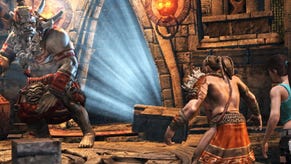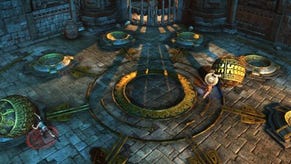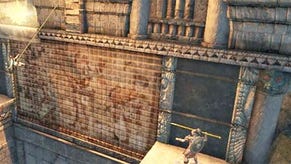Wot I Think: Lara Croft & the Guardian of Light
Earlier this week Lara Croft's latest adventure, an isometric action platformer The Guardian Of Light, was released. Unfortunately, despite being assured, we did not receive review code in time. So rather late, having completed it about twice over, I can tell you Wot I Think.
I really don’t want to write this, because there’s still so many red skulls I haven’t found. There’s levels that still haven’t revealed all their artefacts. And I certainly haven’t completed most of them in the target time. I’ve completed the game twice now, once on 360, a second time on PC, and I’m still compelled to keep replaying the same fourteen levels over and over, finishing the completely unnecessary targets.
I think that says a lot. Crystal Dynamics’ diversion from the traditional Tomb Raider series is a stunning success. Played from an isometric third-person perspective, while strikingly different from the gymnastic escapades of the previous games, it still manages to capture so much of what a Lara game consists of. Despite looking closer to Diablo than Prince of Persia, the game is still very much about acrobatics, well-timed jumps, and elaborate puzzle solving.
If CD have gained one reputation, it’s for being able to create masterful, level-wide puzzles. The very best levels here require you to gather vast stone spheres from many areas, bringing them all together in a central room. Each is hidden behind a particular challenge, meaning there’s constant variation. This is so infrequently a game about blasting through enemies to get to the other end of a corridor, and so often about thinking smartly, manipulating the environment, and searching for useful secrets.
The story is as disposable as a snotty tissue – something about Lara and her new buddy, Totec, a 2000 year old Mayan warrior, chasing after some big cross dude because of something. It didn’t seem important. (The evil Xolotl was imprisoned 2000 years ago by Totec in Mirror of Smoke, and has just escaped. Lara has to retrieve it before dawn – Substance Ed)
Totec’s role only makes sense if you play in multiplayer co-op – something I have not done at this point, because the game, idiotically, cannot be played two-player over the internet. (Jim and I will play some co-op next week and report back.) Otherwise he disappears for huge stretches of time, seemingly uninvolved in events.
But the story is completely unnecessary. This is a playground, packed with challenges, and also a lot of enemies.
There is far more combat than in the regular Tomb Raider games. Lara gathers a remarkable arsenal of weapons, from her trademark pistols to rocket launchers, all of which share a common ammo pool. Enemies attack in huge numbers at times, but a rarely a significant problem. Larger beasts threaten at first, but impressively they can be introduced as boss fights early on, and become just easily disposed of regular enemies later. Not because of artificially changing the difficulty, nor due to Lara’s gaining special equipment, but rather your learning how to better play the game. Even the final boss, despite needing to be killed about forty-seven times, isn’t an unfair or overwhelming task. Just a lengthy one.
However, the weapon you use the most is one of the game’s highlights. The spear. It’s a special magic spear, of course. Let’s call it The Spear Of Cobbletoc. You can throw it infinite times, with the most recent three existing at the same time. Throw a fourth and the first will evaporate. These are an extremely effective attack against most enemies, but also are used for completing various puzzles.
Throwing them into walls creates a bar to help Lara climb, while chucking them at specific targets will trigger switches, and so on. It’s such a fantastic weapon, and one that could do well to make an appearance in Lara’s next full-scale adventure.
The other infinite weapon is the bomb, which Lara can drop anywhere, and then fire later. Again it’s a useful attack, but again again it is more often helpful for puzzles. But I’ll not say how, as figuring that out is much of the fun.
Lara also has her grapple, which is strangely underused throughout, but again makes for a really elegant solution to some of the smarter puzzles.
In fact, so keen is the game on giving you these puzzles that there’s even special, skippable tombs for the toughest trials. Complete them and you’ll get a bonus item, but run straight past and there’s no penalty.
The bonus items let you tweak how you approach the game, and while they don’t have an enormous impact, judicious application can prove helpful. There’s Relics, which are the most powerful bonuses. By the end of the game you may have found some that boost four or five properties at once, from health and ammo regeneration to improving your speed. However, these are only effective when your Relic Meter is filled, completed by killing enemies without damage, and finding gems. Then there’s artefacts, which have a lesser but permanent effect.
Which all combines to having a lot of fun. That’s the key here: it’s just tremendous entertainment. It’s all so well put together, the solutions to challenges smartly hinted at. Often a bonus item will be visible, and it’s in figuring out how to reach it that you’ll uncover how to progress to the next ledge too. The levels are designed with real finesse.
Which also leads to the desire for repeated goes. Completing an area will show you the completion screen, informing you mostly how much you missed. A first play through an area is very unlikely to see you reach the end within the extraordinarily tight time limits. In fact, if you attempt to complete any of the other targets it’s almost impossible that you’ll have sped through quickly enough. Each level also has ten well-hidden red skulls to find, along with level-specific tasks.
These might be to get a large stone ball onto a raised platform elsewhere in the level. It’s not in any way relevant to progress, but it tests your ability to use the skills the game’s taught you in interesting ways. So revisiting completed areas becomes extremely compelling, first to find any collectables you may have missed, then to see if you can achieve the tougher trials, and of course to see if you can take a speed-run.
It looks gorgeous too – it’s made using the same engine as the recent Tomb Raider: Underworld, and includes all the physics you could want for.
Weak points? Well, the lack of online co-op is mystifying. It’s a daft shame. There’s the odd glitch, which sees Lara plummet to yet another of her deaths. Excellent checkpointing means this wouldn’t be a huge issue, if it didn’t punish you by lowering your score for the level. And since you can replay earlier levels with all your equipment from the end of the game, I’d have liked to have seen some new challenges opening up after completion.
It’s fabulous. A real treat, and at fourteen levels it’s plenty long enough too. I’ve played them all at least twice, some of them six or seven times, and am plenty keen to go back to try again. I suggest you do the same.










